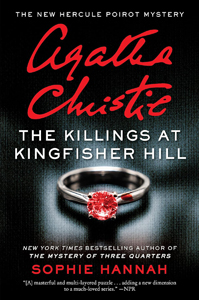Hercule Poirot uses his knowledge of human psychology to solve crimes almost as much as he uses physical evidence. In her Christie estate-commissioned Poirot novels, Sophie Hannah is particularly interested in this method of crime solving, and it’s never been truer than in “The Killings at Kingfisher Hill” (2020).
Complex yet compelling
Hannah’s fourth Poirot outing is an oddly compelling fast read, considering how convoluted it seems to be at first. I was equal parts fascinated and frustrated by the suspects/witnesses. Foremost is Daisy Devonport, who – on the coach journey from London to the titular estate — openly boasts to Poirot about having killed a man.
Daisy’s oddness is paired with bizarre behavior by an unnamed woman, who believes a certain seat on the bus is cursed. On top of this, Poirot and Catchpool are on their way to Kingfisher Hill to investigate a murder where yet another woman is perhaps lying. Helen Acton has inexplicably confessed to killing her brother-in-law Frank Devonport, so her fiancé Richard hires Poirot to find the truth and clear her name.

“The Killings at Kingfisher Hill” (2020)
Author: Sophie Hannah
Series: New Hercule Poirot Mysteries No. 4
Genre: Mystery
Setting: English country estate, 1931
“Kingfisher Hill” is loaded with characters, as so many manor-set puzzle mysteries are. Hannah draws them distinctly and broadly. By reading just a tad deliberately, I kept everyone straight.
The book reminds me a bit of Christie’s non-Poirot masterpiece “Crooked House.” Everyone is flawed or unlikable enough to be a suspect. Both novels examine the consequences of the failure of “nurture” in the process of bringing up a child.
It also has a touch of “Ordeal by Innocence” in how the stress of an unsolved crime hangs over the household. It will not go away until Poirot definitively solves it.
“Crooked House” is more tragic, and the story of the Devonports is more on the amusing side, because patriarch Sidney and his hanger-on wife Lilian are so extreme in their controlling behavior. Still, Hannah does have something true to say about the nature of bottled-up anger and other emotions.
Sifting through the lies
Interestingly, this comes in a novel where the central theme is falsehoods. Audience surrogate Inspector Catchpool (and never have I been more sympathetic to him) can’t see through the myriad misinformation. When Poirot gives him a list of questions to ask the family members, he thinks it’ll be useless.
Poirot responds on page 222: “Do not worry that people may lie to you. That will be as useful as if they tell the truth.”
As always, Poirot has this one solved before Catchpool or the reader. Hilariously, we’re not even halfway through the book before Poirot says he sees the path toward solving the case. It’s just a matter of finding a few more puzzle pieces and slotting them in.

Hannah plays fair and spells things out as clearly as possible (given the game she’s playing). Considering that Poirot initially enters the Devonport manor via a lie – that he and Catchpool are fans of the board game Sidney has co-invented – the book perhaps could’ve delved more into the nature of moral and immoral lies.
Some character behaviors hew close to unbelievable (Sidney in particular is so steeped in anger it’s remarkable he can function). I give a slight edge to “Closed Casket” over “Kingfisher Hill” among Hannah’s first four Poirots.
But the author remains very comfortable at writing Poirot accurately. And Catchpool is a solid audience surrogate, even though it’s becoming ever more apparent that he’s a thinly veiled stand-in for Hastings. I’m ready for the next one, the recently released “Hercule Poirot’s Silent Night.”
Sleuthing Sunday reviews an Agatha Christie book or adaptation. Click here to visit our Agatha Christie Zone.

